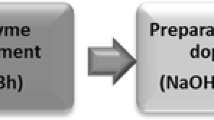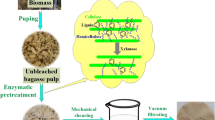Abstract
The rapid coagulation of NaOH-based cellulose solution during the wet spinning process leads to a low stretching ratio and, consequently, the low mechanical properties of the fibres. The aim of this work was to slow down the coagulation by replacing the sulphuric acid spin bath with an acetic acid bath. The spin dope was prepared by dissolving the enzyme-treated dissolving pulp in aqueous sodium zincate using a freezing–thawing method. The optimal zinc oxide and sodium hydroxide concentrations were studied first. The most thermally stable cellulose solution contained 6.5 wt% NaOH and 1.3 wt% ZnO with 6 wt% enzyme-treated dissolving pulp. The spin dope was prepared accordingly. Coagulation of the cellulose solution slowed down in the acetic acid bath, resulting in a significantly higher stretching ratio for the fibres than with the sulphuric acid bath. However, the acetic acid spun fibres shrunk strongly during drying, and the possibly aligned order of the molecular chains due to the high stretch was partly lost. As a consequence, the high stretch was not transferred to high tenacity of the fibres in this study. However, the result suggests attractive potential to develop processing conditions to increase fibre tenacity.


















Similar content being viewed by others
References
Barnes HA (1997) Thixotropy—a review. J Non-Newton Fluid Mech 70:1–30
Bernfeld P (1955) Amylases, α; and β. In: Colowick SP, Kaplan NO (eds) Methods in enzymology, vol 1. Academic, NY, pp 149–158
Cai J, Zhang L (2006) Unique gelation behaviour of cellulose in NaOH/urea aqueous solution. Biomacromolecules 7:183–189
Cai J, Zhang L, Zhou J, Li H, Chen H, Jin H (2004) Novel fibers prepared from cellulose in NaOH/urea aqueous solution. Macromol Rapid Commun 25:1558–1562
Cai J, Zhang L, Zhou J, Qi H, Chen H, Kondo T, Chen X, Chu B (2007) Multifilament fibers based on dissolution of cellulose in NaOH/urea aqueous solution: structure and properties. Adv Mater 19:821–825
Cai J, Zhang L, Liu S, Liu Y, Xu X, Chen X, Chu B, Guo X, Xu J, Cheng H, Han C, Kuga S (2008) Dynamic self-assembly induced rapid dissolution of cellulose at low temperatures. Macromolecules 41:9345–9351
Cao Y, Tan H (2002a) Effects of cellulase on the modification of cellulose. Carbohydr Res 337:1291–1296
Cao Y, Tan H (2002b) The properties of enzyme-hydrolyzed cellulose in aqueous sodium hydroxide. Carbohydr Res 337:1453–1457
Cao Y, Tan H (2006) Improvement of alkali solubility of cellulose with enzymatic treatment. Appl Microbiol Biotechnol 70:176–182
Carillo F, Colom X, Suñol JJ, Saurina J (2004) Structural FTIR analysis and thermal characterisation of lyocell and viscose-type fibres. Eur Polym J 40:2229–2234
Chen X, Burger C, Fang D, Ruan D, Zhang L, Hsiao BS, Chu B (2006) X-ray studies of regenerated cellulose fibers wet spun from cotton linter pulp in NaOH/thiourea aqueous solutions. Polymer 47:2839–2848
Chen X, Burger C, Wan F, Zhang J, Rong L, Hsiao BS, Chu B, Cai J, Zhang L (2007) Structure study of cellulose fibers wet-spun from environmentally friendly NaOH/urea aqueous solutions. Biomacromolecules 8:1918–1926
Colom X, Carillo F (2002) Crystallinity changes in lyocell and viscose-type fibres by caustic treatment. Eur Polym J 38:2225–2230
Davidson GF (1934) The dissolution of chemically modified cotton cellulose in alkaline solutions. Part I. In solutions of sodium hydroxide, particularly at temperatures below the normal. J Text Inst 25:T174–T196
Davidson GF (1937) The dissolution of chemically modified cotton cellulose in alkaline solutions. Part 3. In solutions of sodium and potassium hydroxide containing dissolved zinc, beryllium and aluminium oxides. J Text Inst 28:T27–T44
Egal M, Budtova T, Navard P (2007) Structure of aqueous solutions of microcrystalline cellulose/sodium hydroxide below 0 °C and the limit of cellulose dissolution. Biomacromolecules 8:2282–2287
Fink H-P, Weigel P, Purz H, Ganster J (2001) Structure formation of regenerated cellulose materials from NMMO-solutions. Prog Polym Sci 26:1473–1524
Forziati FH, Rowen JW (1951) Changes in crystalline structure on the infrared absorption spectrum of cellulose. J Res Natl Bur Stand 46:38–42
Fu F, Zhou J, Zhou X, Zhang L, Li D, Kondo T (2014a) Green method for production of cellulose multifilament from cellulose carbamate on a pilot scale. ACS Sustain Chem Eng 2:2363–2370
Fu F, Yang Q, Zhou J, Hu H, Jia B, Zhang L (2014b) Structure and properties of regenerated cellulose filaments prepared from cellulose carbamate–NaOH/ZnO aqueous solution. ACS Sustain Chem Eng 2:2604–2612
Götze K (1967) Chemiefasern nach dem Viskoseverfahren. Springer, Berlin
Grönqvist S, Hakala TK, Kamppuri T, Vehviläinen M, Hänninen T, Liitiä T, Maloney T, Suurnäkki A (2014) Fibre porosity development of dissolving pulp during mechanical and enzymatic processing. Cellulose 21:3667–3676
Isogai A, Atalla RH (1998) Dissolution of cellulose in aqueous NaOH solutions. Cellulose 5:309–319
Jin H, Zha C, Gu L (2007) Direct dissolution of cellulose in NaOH/thiourea/urea aqueous solution. Carbohydr Res 342:851–858
Jurbergs KA (1960) Morphological properties of cotton and wood fibers. Tappi 43:561–568
Kamide K, Okajima K, Kowasaka K (1992) Dissolution of natural cellulose into aqueous alkali solution: role of super-molecular structure of cellulose. Polym J 24:71–86
Kihlman M, Medronho BF, Romano AL, Germgård U, Lindman B (2013) Cellulose dissolution in an alkali based solvent: influence of additives and pretreatments. J Braz Chem Soc 24:295–303
Klemm D, Heublein B, Fink H-P, Bohn A (2005) Cellulose: fascinating biopolymer and sustainable raw material. Angew Chem Int Ed 44:3358–3393
Kotek R (2007) Regenerated Cellulose Fibers. In: Lewin M (ed) Handbook of Fiber Chemistry, vol 3. CRC Press, Taylor & Francis Group, Boca Raton
Krässig HA (1993) Cellulose: structure, accessibility and reactivity. Gordon and Breach Science, Switzerland
Le Moigne N, Navard P (2010) Dissolution mechanism of wood cellulose fibres in NaOH–water. Cellulose 17:31–45
Lilienfeld L (1930) Cellulose solutions and process for making same. US 1771461
Lindman B, Karlström G (2009) Nonionic polymers and surfactants: temperature anomalies revisited. C R Chimie 12:121–128
Lindman B, Karlström G, Stigsson L (2010) On the mechanism of dissolution of cellulose. J Mol Liq 156:76–81
Maloney TC (2015) Thermoporosimetry of hard (silica) and soft (cellulosic) materials by isothermal step melting. J Therm Anal Calorim doi:10.1007/s10973-015-4592-2
Maloney TC, Paulapuro H (2001) Thermoporosimetry of pulp fibers. In: The fundamentals of papermaking materials, transactions of the 12th fundamental symposium held at Oxford vol 2. pp 897–926
Marsh JT, Wood FC (1942) An introduction to the chemistry of cellulose, 2nd edn. Chapman & Hall, London
Mathur NK (2011) Rheology of hydrocolloids in industrial galactomannan polysaccharides. CRC Press, Boca Raton eBook ISBN: 978-1-4398-4629-2
McGarry WJ, Priest MH (1968) Viscose Rayon tire yarn. In: Mark HF, Atlas SM, Cernia E (eds) Man-made fibers science and technology, 2nd edn. Interscience, New York, pp 42–80
Moncrieff RW (1970) Man-made fibres, 5th edn. Heywood Books, The Butterworth Group, England
Morton WE, Hearle JWS (1993) Physical properties of textile fibres, 3rd edn. The Textile Institute, England
Nelson ML, O’Connor RT (1964) Relation of certain infrared bands to cellulose crystallinity and crystal lattice type. Part II. A new infrared ratio for estimation of crystallinity in cellulose I and II. J Appl Polym Sci 8:1325–1341
Oh SY, Yoo DI, Shin Y, Seo G (2004) FTIR analysis of cellulose treated with sodium hydroxide and carbon dioxide. Carbohydr Res 340:417–428
Oh SY, Yoo DI, Shin Y, Kim HC, Kim HY, Chung YS, Park WH, Youk JH (2005) Crystalline structure analysis of cellulose treated with sodium hydroxide and carbon dioxide by means of X-ray diffraction and FTIR spectroscopy. Carbohydr Res 340:2376–2391
Pal R (2006) Introduction to linear viscoelasticity in rheology of particulate dispersions and composites. CRC Press, Boca Raton eBook ISBN: 978-1-4200-1604-8
Qi H, Cai J, Zhang L, Nishiyama Y, Rattaz A (2008a) Influence of finishing oil on structure and properties of multi-filament fibers from cellulose dope in NaOH/urea aqueous solution. Cellulose 15:81–89
Qi H, Chang C, Zhang L (2008b) Effects of temperature and molecular weight on dissolution of cellulose in NaOH/urea aqueous solution. Cellulose 15:779–787
Qin J-J, Gu J, Chung T-S (2001) Effect of wet and dry-jet wet spinning on the shear-induced orientation during the formation of ultrafiltration hollow fiber membrane. J Membr Sci 182:57–75
Radishevskii MB, Serkov AT (2005) Coagulation mechanism in wet spinning of fibres. Fibre Chem 37(4):266–271
Rahkamo L, Siika-Aho M, Vehviläinen M, Dolk M, Viikari L, Nousiainen P, Buchert J (1996) Modification of hardwood dissolving pulp with purified Trichoderma reesei cellulases. Cellulose 3:153–163
Rahkamo L, Vehviläinen M, Viikari L, Nousiainen P and Buchert J (1998) Modification of dissolving pulp by hydrolysis with cellulose enzymes. In: Eriksson L-EL, Cavaco-Paulo A (eds) Enzyme Applications in Fibre Processing. ACS Symp Ser 687. American Chemical Society: Washington, pp 318–327
Ritzoulis C (2013) Introduction to the physical chemistry of foods; Chapter 7 Rheology, pp 157–172. doi:10.1201/b14705-8. ISBN: 978-1-4665-1176-7
Röder T, Moosbauer J, Fasching M, Bohn A, Fink H-P, Baldinger T, Sixta H (2006) Crystallinity determination of man-made cellulose fibers: comparison of analytical methods. Lenzinger Berichte 86:132–136
Rojo E, Alonso V, Dominguez JC, Del Saz-Orozco B, Oliet M, Rodriguez F (2013) Alkali treatment of viscose cellulosic fibers from eucalyptus wood: structural, morphological, and thermal analysis. J Appl Polym Sci. doi:10.1002/app.39399
Ruan D, Zhang L, Zhou J, Jin H, Chen H (2004) Structure and properties of novel fibers spun from cellulose in NaOH/thiourea aqueous solution. Macromol Biosci 4:1105–1112
Treiber E (1981) Cleanness problem for viscose spinning solutions. Ind Eng Chem Prod Res Dev 20:231–237
Vehviläinen M, Nousiainen P, Struszczyk H, Ciechañska D, Wawro D, East G (1996) CELSOL: biotransformation of cellulose for fibre spinning. In: Kennedy JF, Phillips GO, Williams PA (eds) The chemistry and processing of wood and plant fibrous material: cellucon’94 proceedings. Woodhead, Cambridge
Vehviläinen M, Kamppuri T, Rom M, Janicki J, Ciechańska D, Grönqvist S, Siika-aho M, Elg Christofersson K, Nousiainen P (2008) Effect of wet spinning parameters on the properties of novel cellulosic fibres. Cellulose 15:671–680
Vehviläinen M, Nousiainen P, Kamppuri T, Järventausta M (2009) A method for dissolving cellulose and cellulosic product obtained from a solution comprising dissolved cellulose. US Patent 8,492,125 B2, 23 July 2013
Vehviläinen M, Kamppuri T, Nousiainen P, Kallioinen A, Siika-aho M, Elg Christoffersson K, Rom M, Jaroslaw J (2010) Effect of acid and enzymatic treatment of TCF dissolving pulp on the properties of wet spun cellulosic fibres. Cellulose Chem Technol 44(4–6):147–151
von Bucher HP (1968) Viscose Rayon textile fibers. In: Mark HF, Atlas SM, Cernia E (eds) Man-made fibers science and technology, vol 2. Interscience, New York, London, pp 7–42
Wardrop AB (1969) Fiber morphology and papermaking. Tappi 52:396–408
Wilkes AC (2001) The viscose process. In: Woodings C (ed) Regenerated cellulose fibres. The Textile Institute, Woodhead, Cambridge, pp 37–61
Yamane C, Mori M, Saito M, Okajima K (1996) Structures and mechanical properties of cellulose filament spun from cellulose/aqueous NaOH solution system. Polym J 28:1039–1047
Yamashiki T, Saitoh M, Yasuda K, Okajima K, Kamide K (1990) Cellulose fiber spun from gelatinized cellulose/aqueous sodium hydroxide system by the wet-spinning method. Cellul Chem Technol 24:237–249
Yang Q, Qi H, Lue A, Hu K, Cheng G, Zhang L (2011) Role of sodium zincate on cellulose dissolution in NaOH/urea aqueous solution at low temperature. Carbohydr Polym 83:1185–1191
Zhang S, Li F-X, Yu J-Y (2010) Preparation and characterization of novel regenerated cellulose fibers. Chem Fibers Int 4:228–229
Ziabicki A (1967) Physical fundamentals of the fiber-spinning processes. In: Mark HF, Atlas SM, Cernia E (eds) Man-made fibers science and technology, vol 1. Interscience, New York, London, pp 13–94
Acknowledgments
This work was a part of the FuBio Cellulose Program of the Finnish Bioeconomy Cluster FIBIC. Funding from the Finnish Funding Agency for Technology and Innovation (TEKES) is acknowledged. The technical assistance of Maija Järventausta, Mariitta Svanberg, Leena Nolvi and Pekka Laurikainen is gratefully acknowledged.
Author information
Authors and Affiliations
Corresponding author
Rights and permissions
About this article
Cite this article
Vehviläinen, M., Kamppuri, T., Grönqvist, S. et al. Dissolution of enzyme-treated cellulose using freezing–thawing method and the properties of fibres regenerated from the solution. Cellulose 22, 1653–1674 (2015). https://doi.org/10.1007/s10570-015-0632-0
Received:
Accepted:
Published:
Issue Date:
DOI: https://doi.org/10.1007/s10570-015-0632-0




